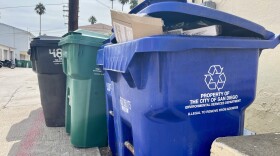The fury of the great storm Sandy shocked a lot of people, like John Miksad, vice president of the New York electric utility Consolidated Edison. "We hit 14-foot tides -- that was the biggest surprise," he told a press conference this week. "The water just kept rising and rising and rising."
That rising water flooded streets, buildings and parts of the city's underground electricity grid. Hundreds of thousands of New Yorkers lost power. But it might have been worse if the power lines had not been underground.
Manhattan's grid sits like a gigantic plate of spaghetti under the city's streets and buildings -- miles and miles of electric cable. After the 14-foot tide went up and over, it went down under, soaking a lot of that spaghetti network -- cables, transformers, switches; all the stuff that's hidden under those manhole covers in New York's streets.
"It's a whole different world down there, believe me," says Gregory Reed. He teaches power engineering at the University of Pittsburgh, but he used to crawl down those manholes for Con Ed, to fix their grid. "It is very cramped," he says. "There's seldom room for more than one person at a time to do their work. So it's very difficult conditions."
And that's what a small army of workers is doing now -- squirming through narrow tunnels under Manhattan. They're checking hundreds of transformers that regulate the electricity's voltage -- those gray cylinders you normally see perched on power poles. And they're looking for cables that got damaged. "It's not always easy to predict where that fault is in the underground system," says Reed, "because we can't see it, so what you have to do is go out and test it section by section."
Even equipment that's not obviously damaged has to be tested. And that could mean turning power off and on for a while in a neighborhood; that's pretty annoying if you just got your power back. But Reed says it would've been worse if the city's grid were aboveground.
"Consider this case," he says. "If all of the infrastructure was overhead, the vast majority would be laying on the ground." In fact, Con Ed officials say repairing aboveground regions of the area will take three or four times as long as fixing the underground network.
One reason Manhattan's underground system is resilient is that it gets wet all the time. That's according to energy expert Roger Anderson at Columbia University, who has been a consultant to Con Ed. "In the winter we put salt down on the roads," he explains. "The salt melts, and the transformers under the streets are routinely dealing with saltwater. So all that Con Edison needs to do is to drain the water out of the transformers, hose them down, and flip the circuit breaker again."
Anderson concedes, though, that flooding poses other threats. "Flooding has all kinds of contaminants in the water, a lot of oils, and also it comes in violently -- it can wash away things." Things like transformers that can get knocked off their moorings.
Even as the grid gets fixed, there's the problem of the subways. Several subway tunnels have been flooded, and there's lots of electrical equipment in those tunnels. For example, if you've been on a New York subway, you've seen the red and green lights along the tunnel. Those are switches that monitor where every train is, and they all have to be checked. "And in order to do that," Anderson explains, "you've got to physically walk or ride the length of the track."
It's a big, big job with a big price tag. So, it's to be expected that New Yorkers are asking: Will climate change make this keep happening over and over? It's the second year in a row that a hurricane has hit New York. Last year it was Irene.
Climate scientists caution that no single weather event is proof of climate change. But computer projections of future warming do predict bigger storms.
At a press conference in New York, Mayor Michael Bloomberg said he's seen enough to act. "Let's assume that we decide that we're not damaging our planet and later on find that we were," the mayor said. "It literally could be too late."
But just what to do to protect New York awaits months of post-storm analysis by engineers and oceanographers and other experts, followed by action by politicians and industry, who will have to raise many billions of dollars to pay to keep the Big Apple afloat.
Copyright 2012 National Public Radio. To see more, visit www.npr.org.





